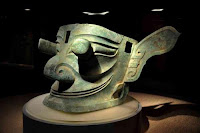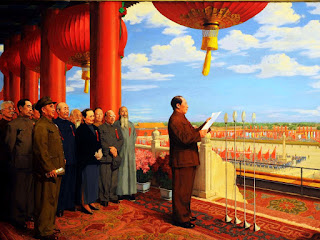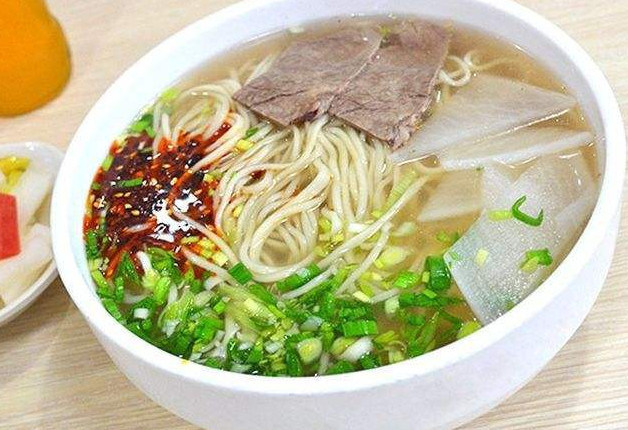Sanxingdui Ruins
Sanxingdui Historic Site is located in the southern side of the Yazi River, northwest of Guanghan city. It’s regarded as one of the most significant discoveries in the 20th century. The Sanxingdui Civilization followed the Baodun Culture and preceded the Jinsha Culture, lasting about 2000 years. Therefore, it’s an important civilization center in the Yangtze River area and earliest civilization in Chinese history. The untraceable age, unsolvable history puzzles, bizarre bronzes, and the enigmatic ancient Shu Kingdom only make the place more appealing to visitors.
phases. Phase 1 is about Baodun Culture (Former Shu Culture), the phase 2 and 3 are about Sanxingdui Culture (the Ancient Shu Kingdom, after 1600B.C), and phase 4 is about Shierqiao Culture, whose relics are mainly preserved in Jinsha Ruins.
The excavation of Sanxingdui Ruins started in the early 20th century and a substantial discovery was made, including three city walls, house foundations, puts, tombs, sacrificial pits, etc. There are circular, square, and rectangular three shapes of house foundations. Most of the buildings are wooden. Tons of jade, bronze, shells, potteries, ivories, and golden wares are excavated in the sacrificial pits. Among the golden wares, the Golden Sceptre and Golden Mask are the finest. Among all the bronze wares, the Bronze Masks and Life-sized Bronze Figures are the most striking ones. These bronze heads are all exaggerated and carry strong characteristics. The Bronze Figures also wear gowns, which became great materials for the study of the clothing in the ancient Shu Kingdom.
All the relics and historical documents suggest that there is no vassal relationship
between the ancient Shu Kingdom and the central dynasties of China. Instead, the ancient Shu Kingdom was an independent kingdom. The oracle bone inscriptions from Shang Dynasty also tell us that the Shang army used to fight against Shu people, but most of the battles began well but end badly. Meanwhile, Shang Dynasty weapons, truncheons, vessels inscribed with the Shang Dynasty characters are buried as war trophies. All these clearly tell us that the ancient Shu Kingdom was a giant power.
the area was a relatively closed society, which had no or very few connections with central China. However, the Sanxingdui Ruins suggests that the Bashu area might even be an earlier civilization center and it maintained some connections with central culture. Besides, the previous historians believed that the Chinese civilization started from the Yellow River basin and got introduced to other places in China. While the discovery of Sanxingdui Ruins made people revisit the proposal and it seemed that just like the Yellow River, the Yangtze River basin was also an essential civilization center, an earlier and more powerful one.
In the two large pits, there are thousands of bronze, gold, and jade vessels
discovered, and bronze wares are the most. In Pit 1, bronze wares of a human head, human face, human mask, kneeling figures, dragon ornaments, dragon-shaped objects, tiger-shaped wares, dagger-ax, rings, dragon-tiger Zuns, goat Zuns, vases, and plates were found. While in Pit 2, besides the bronze wares similar to that of Pit 1’s, there are also bronze animal masks, animal faces, altar, divine trees, sun-shaped ornaments, eye-shaped ornaments, bells, birds, snakes, roosters, beasts, buffalo heads, deer, and catfish.
All these bronze wares were not just random objects, each had their meanings. The bronze human heads, human faces, and human masks represented the ancestors and deities worshiped. The standing bronze figures represented the worshipers and the kneeling bronze figures were the hosts of the sacrificial rituals. The strange bronze animal masks must be some natural deities that ancient Shu people worshiped. While the bronze trees resembling the real plants reflected that ancient Shu people also took worship in plants. Therefore, religious ideas and the spiritual world of ancient Shu people are revealed.
According to Records of Huayang, Shu King Can Cong had strange eyes. Scholars
believed that the protruding eyes we see in the Sanxingdui ruins came from Can Cong’s strange eyes. History records have it that Shu King Can Cong originally resided in Wenshan County, the upper reach of Minshan. This place was rich in natrite, from which salt could be made. Historians assumed that Can Cong must be a serious hyperthyroidism patient due to the long-time consumption of the special salt. One of the important syndromes of hyperthyroidism is the bulging eyes. The fact is until modern times, Wenshan County was still one of the places with iodine deficiency, many modern people suffered from hyperthyroidism. Therefore, the hypothesis of Can Cong being a hypothesis is very likely to be true. His descendants captured the feature and further deified it. This is why the Shu King’s eyes were made protruding and strange.
It’s well believed that Chinese civilization started from Yellow River in 4000 years ago. The Sanxingdui Ruins reveal that the history of ancient Shu Kingdoms can be traced to 5000 years ago. So, when and where did the Chinese civilization began? There is no unanimous answer.
Sanxingdui Ruins suggest that the ancient Shu Kingdom lasted about 1500 years and then disappeared in history, leaving the following 2000 years a great mystery. It’s hard to imagine that a powerful kingdom like Shu can perish in a place with warm temperatures, fertile land, and abundant resources.
From the numerous bronze wares of Sanxingdui Ruins, there are few daily used
wares. Most of them are sacrificial wares, which indicates that the ancient Shu Kingdom had a relatively mature religious system. Some of the sacrificial objects also had marks of foreign culture characteristics, especially the Maya Civilization and Egyptian Civilization. In addition, there were over 5000 seashells discovered in Sanxingdui pits, which were identified to come from the Indian Ocean. Nevertheless, it’s still hard to say there is a definite connection between the Shu Kingdom and Maya Civilization or Egyptian Civilization.
There are tons of pottery pieces excavated from Sanxingdui Ruins, which illustrated that there were many kinds of potteries at that time. On these potteries, there are some irregular symbols. People have different opinions on what they are. Are the characters, clan badges, or religious symbols. We don’t know.
As a powerful regime as the Shu Kingdom, why is there no written record? All the excavations proved that Sanxingdui is a well-established civilization. The only thing missing is the written record.
 |
| Sanxingdui Discoveries |
Sanxingdui Ruins
Sanxingdui Ruins belong to the Bronze Age and they can be traced back to 2800B.C-1100B.C, roughly at the time of Xia and Shang Dynasties. The whole ruins have four |
| Bronze Mask |
The excavation of Sanxingdui Ruins started in the early 20th century and a substantial discovery was made, including three city walls, house foundations, puts, tombs, sacrificial pits, etc. There are circular, square, and rectangular three shapes of house foundations. Most of the buildings are wooden. Tons of jade, bronze, shells, potteries, ivories, and golden wares are excavated in the sacrificial pits. Among the golden wares, the Golden Sceptre and Golden Mask are the finest. Among all the bronze wares, the Bronze Masks and Life-sized Bronze Figures are the most striking ones. These bronze heads are all exaggerated and carry strong characteristics. The Bronze Figures also wear gowns, which became great materials for the study of the clothing in the ancient Shu Kingdom.
All the relics and historical documents suggest that there is no vassal relationship
 |
| Bronze Mask with Protruding Eyes |
Sanxingdui Culture
Bashu Culture
The discovery of Sanxingdui Ruins subverted people’s ideas about the Bashu culture. Historians used to believe that compared to the central civilizations of China, Bashu |
| Standing Bronze |
Bronze Culture
As one of the capitals of the ancient Shu Kingdom, Sanxingdui Ruins host thousands of priceless relics and antiques. Most of the relics were sacrificial objects from ancient Shu court. It’s assumed that those relics belonged to the former court and they were dumped into the sacrificial pit when the country was controlled by a new dynasty.In the two large pits, there are thousands of bronze, gold, and jade vessels
 |
| Divine Tree |
All these bronze wares were not just random objects, each had their meanings. The bronze human heads, human faces, and human masks represented the ancestors and deities worshiped. The standing bronze figures represented the worshipers and the kneeling bronze figures were the hosts of the sacrificial rituals. The strange bronze animal masks must be some natural deities that ancient Shu people worshiped. While the bronze trees resembling the real plants reflected that ancient Shu people also took worship in plants. Therefore, religious ideas and the spiritual world of ancient Shu people are revealed.
Ancestor Worship
If we observe these bronzes closely, we can see that many of them highlighted “eyes”. Many eyeballs are extremely exaggerated and the pupils are protruding in a cylinder shape, some can even be 16.5cm long. There are also various eye ornaments. Why did ancient Shu people emphasize the eyes so much? Why did they make pupils in such a peculiar shape? It has something to do with their ancestor worship complex.According to Records of Huayang, Shu King Can Cong had strange eyes. Scholars
 |
| Religious Symbol |
5 Unsolved Mysteries of Sanxingdui Ruins
It’s well believed that Chinese civilization started from Yellow River in 4000 years ago. The Sanxingdui Ruins reveal that the history of ancient Shu Kingdoms can be traced to 5000 years ago. So, when and where did the Chinese civilization began? There is no unanimous answer.
- 2.How did the ancient Shu Kingdom disappear in history?
Sanxingdui Ruins suggest that the ancient Shu Kingdom lasted about 1500 years and then disappeared in history, leaving the following 2000 years a great mystery. It’s hard to imagine that a powerful kingdom like Shu can perish in a place with warm temperatures, fertile land, and abundant resources.
- 3. Is there any connection between the Shu Kingdom and Maya Civilization or Egyptian Civilization?
From the numerous bronze wares of Sanxingdui Ruins, there are few daily used
 |
| Mysterious Characters |
- 4. What’s the meaning of the symbols on the potteries?
There are tons of pottery pieces excavated from Sanxingdui Ruins, which illustrated that there were many kinds of potteries at that time. On these potteries, there are some irregular symbols. People have different opinions on what they are. Are the characters, clan badges, or religious symbols. We don’t know.
- 5. Why is there no written record?
As a powerful regime as the Shu Kingdom, why is there no written record? All the excavations proved that Sanxingdui is a well-established civilization. The only thing missing is the written record.
Sanxingdui Museum
Sanxingdui Museum is located nearby the Sanxingdui Ruins. It’s a large-scale thematic museum dedicated to displaying the Sanxingdui excavations. With an area of 33 hectares, the whole museum has two exhibition halls. The first exhibition hall mainly hosts golden, copper, jade, stone and pottery wares, and while the second exhibition hall is all about bronze.Recommended Itinerary:
2 Days Classic Chengdu Tour
 |
| Sanxingdui Museum |




Comments
Post a Comment